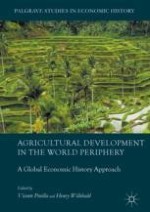2018 | OriginalPaper | Chapter
14. Agricultural Development in Australia: 1845–2015
Author : Kym Anderson
Published in: Agricultural Development in the World Periphery
Publisher: Springer International Publishing
Activate our intelligent search to find suitable subject content or patents.
Select sections of text to find matching patents with Artificial Intelligence. powered by
Select sections of text to find additional relevant content using AI-assisted search. powered by
